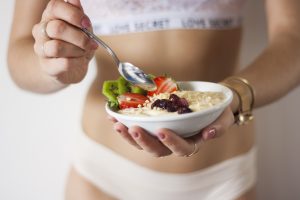 If you come to LIV Fitness in Dublin, CA, or use our app instead, you’ll notice we focus on more than just exercise. Having a healthy diet is just as important no matter what your fitness goal. No matter how long and hard you train, you’ll never out-train a bad diet. That’s why we emphasize a diet that eliminate foods high in sugar and those highly processed. It’s also why we focus on nutrient dense foods, whole foods and high fiber foods. High fiber foods not only fill you up and keep you feeling full longer, they feed beneficial microbes in your digestive tract to maximize health benefits.
If you come to LIV Fitness in Dublin, CA, or use our app instead, you’ll notice we focus on more than just exercise. Having a healthy diet is just as important no matter what your fitness goal. No matter how long and hard you train, you’ll never out-train a bad diet. That’s why we emphasize a diet that eliminate foods high in sugar and those highly processed. It’s also why we focus on nutrient dense foods, whole foods and high fiber foods. High fiber foods not only fill you up and keep you feeling full longer, they feed beneficial microbes in your digestive tract to maximize health benefits.
There are two types of fiber, soluble and insoluble.
Soluble fiber turns into a gel when mixed with liquids, while insoluble doesn’t digest, but passes through your digestive system, adding bulk and keep stools softer and easier to pass. Both types of fiber are important. Insoluble fiber slows the digestion and absorption of carbohydrates, so it helps level blood sugar. Insoluble fiber can help prevent constipation, hemorrhoids and lower the risk of cancer. Some of the best sources of insoluble fiber include berries, oat bran, whole grains, beans, spinach and nuts.
Boost your energy and enjoy a sweet treat when you eat fiber.
If you want to keep your energy level at its peak, eat a serving of sweet potatoes. These high fiber veggies slow carbohydrate digestion, which helps you have a more consistent blood sugar level throughout the day. If you want more sweet evidence, check out apples, bananas, oranges and pears. All are high in fiber and increase your energy, while reducing your appetite. They all are high in other nutrients to help your body in other ways. Apples are a top choice for women and just like pears, should be eaten with the skins on for maximum benefit.
One reason to have a meatless Monday is the benefits from eating beans.
Beans are often a highly underrated source of protein and fiber. They’re versatile and inexpensive, so why not have some navy beans for your next meal. It only takes a half cup of cooked navy beans to provide as much as 34% of your daily fiber requirement. They’re easy to store and have a long shelf life, so you can keep plenty on hand. Beans are high in thiamin and folate, which improves brain health. They lower the risk of heart disease, diabetes, cancer, as they improve digestion and circulation. Beans also help in cell growth and repair.
- Finding ways to boost your fiber intake can be as simple as adding a few more veggies to your meal. Green peas, butternut squash and even white potatoes if skins are left on them, are good sources of fiber.
- Soluble fiber is a prebiotic that feeds beneficial microbes. Your microbiome, the microbes in your body, affect all bodily functions. In fact, you have more microbes than cells.
- Oatmeal is a good source of fiber and has been shown to not only help slow sugar absorption, keeping you feeling full longer, but also is beneficial for lowering cholesterol levels. Other whole grain products are also beneficial.
- Not only do most fruits and vegetables provide high amounts of fiber, they also provide other nutrients. Berries, such as blueberries, strawberries and raspberries, provide an antioxidant that’s called anthocyanin, which has numerous health benefits.
For more information, contact us today at LIV Fitness
